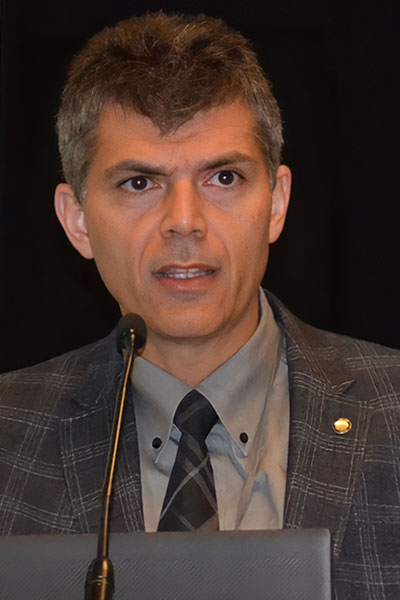
Recent changes to the US Preventive Services Task Force (USPSTF) lung cancer screening (LCS) guidelines have the potential to reduce historic health care disparities. On Tuesday morning at CHEST 2022, an expert panel convened at the session Updates in Lung Cancer Screening: Disparities, New Guidelines, and Implementation to provide attendees with a comprehensive update on those guidelines and the current LCS guidelines from CHEST and other groups.
Current LCS guidelines are primarily based on two studies, the NELSON Trial and the National Lung Cancer Screening Trial (NLST), said Peter J. Mazzone, MD, MPH, FCCP, editor in chief of the journal CHEST® and director of the lung cancer program for the respiratory institute of the Cleveland Clinic and the lung cancer screening program and nodule management program for the Cleveland Clinic. NELSON and NLST, as well as a few other trials that weren’t specifically powered to detect a reduction in lung cancer mortality, established the benefit of LCS with low-dose computed tomography (CT).
The updated USPSTF lung cancer screening guidelines lowered the age for starting LCS from 55 to 50 years and reduced the minimum smoking history from 30 to 20 pack-years, compared to the 2013 USPSTF criteria.
“This change leads to an increase in lung cancer mortality reduction from 9.8% to 13% compared to their older criteria,” Dr. Mazzone said. “But it also leads to an increase in how many people will be screened—about 87% overall—as well as a greater percentage increase in those who are currently not receiving equitable access to screening and more harm—2.2 vs 1.9 false-positive results per person who is screened.”

CHEST updated its lung cancer screening guidelines in July and now recommends an annual screening with low-dose CT for asymptomatic individuals ages 55 to 77 who have smoked 30 pack-years or more and either continue to smoke or have quit within the past 15 years. For asymptomatic individuals who do not meet that smoking and/or age criteria, who are ages 50 to 80, have smoked 20 pack-years or more, and either continue to smoke or have quit within the past 15 years, CHEST also recommends annual screening with low-dose CT. The first criteria align with the eligibility criteria for Centers for Medicare & Medicaid coverage, while the second criteria align with the USPSTF’s 2021 update.
By expanding the eligibility criteria to include more people, the USPSTF’s updated LCS guidelines have the potential to decrease historic disparities in access to lung cancer screening and treatment among vulnerable, underserved, and racially and ethnically diverse populations, said Louise M. Henderson, PhD, MSPH, professor of radiology and epidemiology at the University of North Carolina School of Medicine and program co-lead of cancer epidemiology at the university’s Lineberger Comprehensive Cancer Center.
But Dr. Henderson said it’s important to note that the updated USPSTF guidelines still don’t recommend the use of risk-prediction models to determine LCS eligibility. That’s because the task force determined that there’s insufficient evidence to indicate whether risk models impact outcomes. Similarly, the 2013 recommendations didn’t consider the impact of racial, ethnic, socioeconomic, or sex-based differences in smoking behaviors on lung cancer risk, she said.
“Some have raised concerns that the 2013 USPSTF lung cancer screening eligibility criteria created racial and ethnic disparities,” Dr. Henderson said. “And while expanded eligibility criteria are an important step to equity, it’s not enough to eliminate disparities. We must address disparities and implementation challenges to get lung cancer screening to areas in need.”

One area of need is the rural setting, where disparities in lung cancer incidence between White and Black individuals is even higher than it is in urban areas, said Nichole T. Tanner, MD, MSCR, FCCP, professor of medicine at the Medical University of South Carolina, co-director of lung cancer screening at the university’s Hollings Cancer Center, and director of lung cancer screening at the Ralph H. Johnson VA Medical Center.
She noted that in rural counties, cigarette smoking is more prevalent, more smokers consume over 15 cigarettes a day, and the overall incidence of lung cancer is 20% higher than in urban areas. Despite this, rural areas are much less likely to have accredited, comprehensive LCS programs, she said.
“We know that the task force recommendations are increasing the number of eligible [people], but it’s really hard to say that that’s actually going to increase uptake,” Dr. Tanner said. “Lung cancer screening is extremely complex. I wish I could just say it was one scan, but it’s not. There are many barriers, and continued efforts to develop and support interventions to address these barriers are needed—because we know that cancer screening really does save lives.”
This session was supported by an educational grant from Merck Sharp & Dohme, LLC, Sanofi, Daiichi Sankyo, Inc., and AstraZeneca Pharmaceuticals.
Join us at CHEST 2025
Save the date for the next Annual Meeting, October 19 to 22, 2025, in Chicago. CHEST 2025 will explore the latest advancements in pulmonary, critical care, and sleep medicine, with a focus on innovation and the future, just as the city itself embodies progress and reinvention.





